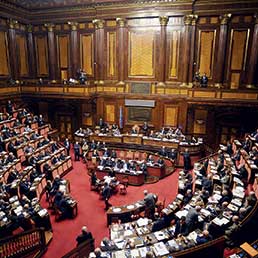Storia dell'articolo
Chiudi
Questo articolo è stato pubblicato il 23 febbraio 2013 alle ore 08:14.

What has been a long and noisy election campaign came to an end yesterday. Italians are accustomed to the highs of the electoral buzz but maybe this time will appreciate more than ever the "electoral silence" that starts today: a stop to rallies, political campaign posters and television coverage.
The undecided are still numerous and their final choice, which will be evident shortly, will be decisive in terms of the future Parliament and Government of the country. But now we must see how those undecided voters translate into seats. The electoral system is complex because of the two branches of Parliament having different rules. In the House the majority is secured with a bonus: the party in first position always gets a total of 340 seats (25 more than the required majority). In the Senate, however, the seats are assigned related to regional majorities. Only those parties that obtain more than 8% of the vote will get seats (this assumes they are not in coalition with other parties). The race to the Senate, where the majority must have at least 158 seats, is very complex: it is not enough to nationally get a majority of votes. It is important that parties win in the larger regions: Lombardy (49 seats), Campania (29), Sicily (25) and Veneto (24).
The "forbidden" polls during the last two weeks prior to the vote, indicated that it is very likely that the center-left, a coalition of the PD and Sel, will not be able to form a government by itself, needing the votes of Mario Monti's centrist coalition. Again, this scenario is given as a probable outcome rather than a sure one.
The real novelty of these elections may be Beppe Grillo's Movimento 5 Stelle, a party led by a comedian turned blogger, who quickly rose in the polls, thanks to his anti-establishment messages on a number of issues including the euro, to perhaps become the second party behind the PD. Grillo will bring in a large number of Parliamentary MPs. This will ensure something of a renaissance (as we saw in the early 90s, at the time of Tangentopoli) but with a degree of fragmentation in the new Parliament. In 2008, there were two coalitions represented in Parliament (center-right and center-left), in 2013 there may be as many as six.
The first formal act of the new Parliament will be the formation of parliamentary groups and the election of two presidents, both offices of primary importance. The President of the Senate, for example, carries out the functions of the President of the Republic, as written in the constitution, when the President cannot perform them personally. One of the possible candidates for this chair is Monti. From 15 April, Parliament will have yet another important task: to elect a new head of state (Giorgio Napolitano has ruled out his possible re-election).
But we will not have to wait much longer to see where Italy is going. The vote takes place tomorrow and Monday up until 3.00 pm. The count will begin starting with the Senate. By late Monday evening, some light will be shed on seats assigned to the Upper House, which is a critical step in understanding who will eventually lead the country.
#insightelections2013
(Traduzione di James Tierney)
Permalink
Dai nostri archivi
Moved Permanently
The document has moved here.










